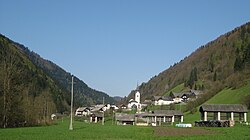Zali Log
Zali Log | |
|---|---|
 | |
| Coordinates: 46°12′23.66″N 14°6′4.17″E / 46.2065722°N 14.1011583°E | |
| Country | |
| Traditional Region | Upper Carniola |
| Statistical region | Upper Carniola |
| Municipality | Železniki |
| Elevation | 526.8 m (1,728 ft) |
| Population (2002) | |
• Total | 247 |
| [1] | |
Zali Log (pronounced [ˈzaːli ˈloːk]; German: Salilog[2]) is a village in the Municipality of Železniki in the Upper Carniola region of Slovenia.
Name
[edit]Zali Log was attested in historical sources as Stubem in 1485–1490, Stuben in 1500, and Salemlogu in 1500.[3][4] The name is derived from *Zъ̀lъjь lǫ̂gъ in the sense of 'bad (marshy) meadow' (cf. Hudi Log for a toponym with a similar semantic motivation).[4]
History
[edit]Zali Log is a relatively recent settlement. In the 14th century, Tyroleans settled the area, establishing the village of Micheltal on the southern slope of Mount Groblje (elevation: 1,086 meters or 3,563 feet), where there are now hay meadows. They soon left the higer elevations and founded the village of Ka Stuben, where today's village of Zali Log is located.[5][6]
During the interwar period, Zali Log was on the Yugoslav side of the Rapallo border between Italy and Yugoslavia. Between 1937 and 1941, Yugoslavia constructed a series of fortifications and weapons installations known as the Rupnik Line, part of which ran through the territory of Zali Log. Various machine-gunner pillboxes are preserved along the southern slope of Mount Groblje and along the Davča River in the southeastern part of Zali Log.[7]
Churches
[edit]The parish church in Zali Log dedicated to the Assumption of Mary. It is an originally Gothic church, redesigned in the Baroque style in the 1740s. It contains a ceiling fresco by Janez Gosar and an altar painting by Janez Wolf.[5] A second church stands on Suša Hill east of the settlement. It is dedicated to Our Lady of Loreto and was built from 1875 to 1876 where a wayside shrine formerly stood.[8] It was built in the Renaissance Revival style and was designed by Franc Faleschini.[9]
Gallery
[edit]-
Zali Log
References
[edit]- ^ Statistical Office of the Republic of Slovenia Archived November 18, 2008, at the Wayback Machine
- ^ Leksikon občin kraljestev in dežel zastopanih v državnem zboru, vol. 6: Kranjsko. Vienna: C. Kr. Dvorna in Državna Tiskarna. 1906. p. 62.
- ^ "Orle". Slovenska historična topografija. ZRC SAZU Zgodovinski inštitut Milka Kosa. Retrieved January 20, 2023.
- ^ a b Snoj, Marko (2009). Etimološki slovar slovenskih zemljepisnih imen. Ljubljana: Modrijan. p. 475.
- ^ a b Savnik, Roman (1968). Krajevni leksikon Slovenije, vol. 1. Ljubljana: Državna založba Slovenije. p. 385.
- ^ Planina, France (1962). Poljanska in Selška dolina. Ljubljana: Mladinska knjiga. p. 120.
- ^ "Zali Log - Bunkerji Rupnikove linije". Register kulturne dediščine. Republika Slovenija, Ministrstvo za kulturo. Retrieved September 21, 2025.
- ^ Zgodovina cerkve posvečene Loretski materi božji v Suši. Information sign posted at the church.
- ^ Slovenian Ministry of Culture register of national heritage reference number ešd 2701.
External links
[edit]- Media related to Zali Log at Wikimedia Commons

- Zali Log on Geopedia
- Zali Log web site Archived 2008-10-21 at the Wayback Machine







